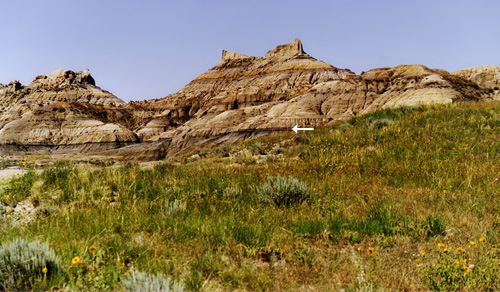
The dark band in this photo (indicated by the arrow) of the Hell Creek Formation in Montana is known as the z-coal, a coal layer that marks the approximate boundary between Cretaceous (below) and Tertiary (above) age rocks.
The Mesozoic Era
The Mesozoic Era is divided into three time periods: the Triassic (251-199.6 million years ago), the Jurassic (199.6-145.5 million years ago), and the Cretaceous (145.5-65.5 million years ago).*

The dark band in this photo (indicated by the arrow) of the Hell Creek Formation in Montana is known as the z-coal, a coal layer that marks the approximate boundary between Cretaceous (below) and Tertiary (above) age rocks. |
Mesozoic means "middle animals," and is the time during which the world fauna changed drastically from that which had been seen in the Paleozoic. Dinosaurs, which are perhaps the most popular organisms of the Mesozoic, evolved in the Triassic, but were not very diverse until the Jurassic. Except for birds, dinosaurs became extinct at the end of the Cretaceous. Some of the last dinosaurs to have lived are found in the late Cretaceous deposits of Montana in the United States.
The Mesozoic was also a time of great change in the terrestrial vegetation. The early Mesozoic was dominated by ferns, cycads, ginkgophytes, bennettitaleans, and other unusual plants. Modern gymnosperms, such as conifers, first appeared in their current recognizable forms in the early Triassic. By the middle of the Cretaceous, the earliest angiosperms had appeared and began to diversify, largely taking over from the other plant groups.
Mesozoic fossil localities
Blue Nile Gorge, Ethiopia: Come along on a fossil-hunting trip to Ethiopia with UCMP researchers and see the first dinosaur fossils found there.
Clayton Lake, New Mexico: This Cretaceous site has some of the most extensive and best preserved dinosaur trackways in the United States.
Ischigualasto, Argentina: The best-known and best-preserved early dinosaurs come from this Triassic locality in South America.
Pt. Loma Formation, California: This Cretaceous locality has yielded important fossils for understanding western North American dinosaurs.
Karoo Basin, South Africa
Solnhofen Limestone, Germany: Exquisitely detailed fossils have come from these Jurassic deposits in southern Germany.
Resources
* Dates from the International Commission on Stratigraphy's International Stratigraphic Chart, 2008.
David Polly created the original page 12/6/1993; Allen Collins made additions and broke the original page into multiple pages 11/26-28/1994; Sarah Rieboldt updated the pages to reflect the Geological Society of America (GSA) 1999 Geologic Timescale, 11/2002; Dave Smith recombined the content into a single page and adapted it to the new site format, 6/15/2011; Hell Creek Formation photo by Dave Smith, UCMP